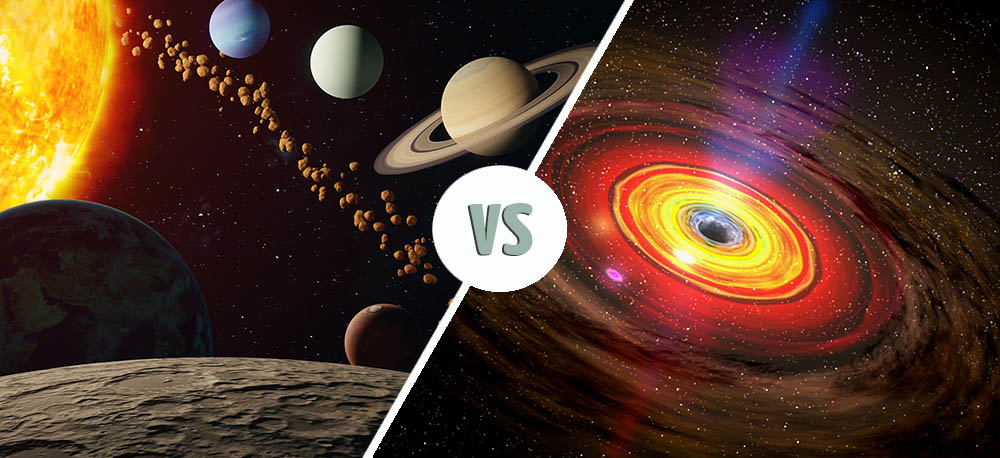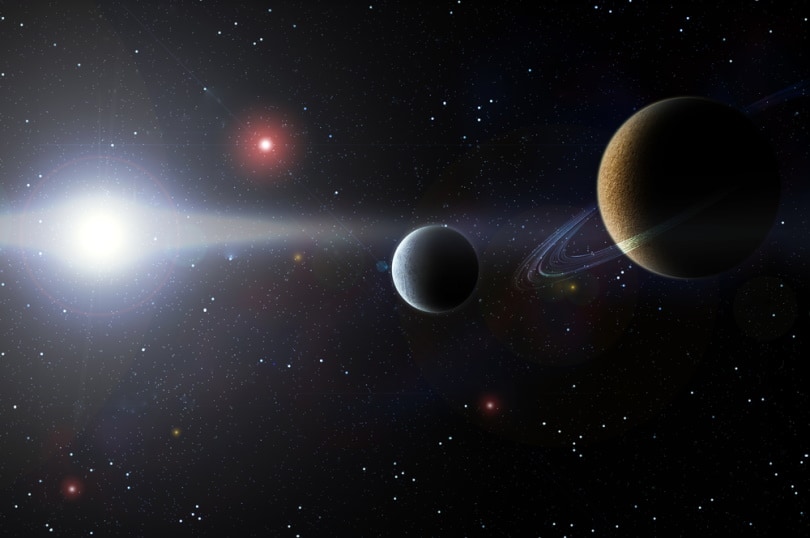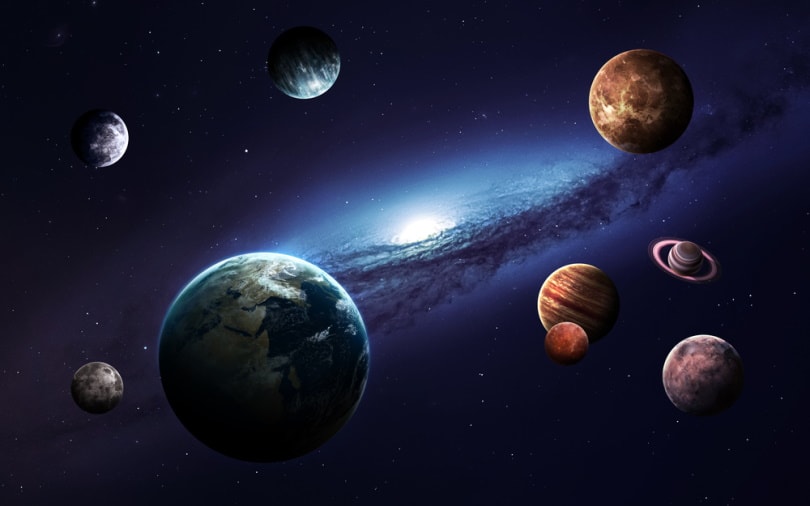Solar System vs. Galaxy: What’s the Difference?
Last Updated on

Space is a complicated and intricate domain that can be difficult to understand, so many people are unclear about the differences between our solar system and galaxies. Our solar system is incomprehensibly small compared to the Milky Way galaxy, which we call home. Our Sun is just one of the hundreds of billions of stars and planetary systems sharing our galaxy.
Let’s take a closer look at the basics to understand our cosmic address and the differences between our solar system and the innumerous galaxies populating the universe.

Overview of the Solar System
The solar system is a collection of gravitationally bound objects orbiting a common star. In our case, the various celestial objects in our solar system all orbit the Sun. Although there are many similar planetary systems to ours in the universe, ours is named after our Sun, or “Sol,” in Latin.
Our solar system consists not only of our Sun but also everything bound to it due to its massive and attractive gravitational force. Because the Sun is so huge, it pulls the planets, hundreds of moons, and millions of asteroids and comets into an orbit around it. This is the essential framework of our solar system as well as all other planetary systems in the universe. If a planetary system has more than one star, it is called a stellar system, of which there are countless examples in the universe.

How Many Planets are in our Solar System?
The number of planets in our solar system is a topic of hot debate amongst scientists and hobbyists alike. There are eight planets in our solar system; however, up until 2006, there used to be a ninth planet. Pluto, which has since been demoted to a dwarf planet, officially lost its planet status after the International Astronomical Union (IAU) formalized its definition of a “planet.”
In order to be considered a planet, a celestial body must clear the neighborhood around its orbit, orbit the Sun, and have sufficient mass to maintain hydrostatic equilibrium, which is technical terminology for maintaining a nearly-round shape. Although Pluto fulfills the latter two criteria, it has not cleared its orbital neighborhood due to the presence of the Kuiper Belt, which contains trillions of small, icy bodies and comets.
Despite this definition, many planetary scientists still consider Pluto to be a planet, so its status really boils down to a matter of preference. Pluto is officially recognized as a dwarf planet; however, our solar system contains other types of planets, including terrestrial, gas giant, and ice giant planets.
Types of Planets in our Solar System
Our solar system contains three types of planets, including terrestrial worlds, gas giants, and ice giants. Depending on a planet’s composition, it can be classified into one of these three categories, which are explained below.

The Terrestrial Planets
The terrestrial planets in our solar system are Mercury, Venus, Earth, and Mars, which all occupy its innermost region and are closest to the Sun. One of the defining characteristics of a terrestrial planet is its compact, rocky surface, much like Earth’s.
Terrestrial planets typically have a molten core made of heavy metals such as iron and nickel, while their surfaces are generally composed of silicate materials. The surfaces of terrestrial planets are characterized by the presence of mountains, valleys, canyons, and craters, which can vary based on the presence of water and tectonic activity.
The Gas Giants
The gas giants, also referred to as the Jovian planets, include Jupiter and Saturn. They are characterized by a mixture of swirling gasses around a solid core and contain most of the same elements as stars, including hydrogen and helium. As such, they are sometimes referred to as “failed stars.” Although Jupiter and Saturn are among the largest planets in our solar system, they are not massive enough to jumpstart the thermonuclear reactions necessary for stars to form.
Because gas giants do not have a well-defined surface, it is impossible to land on them. A gas giant’s atmosphere gradually becomes denser towards the core and may contain liquid or liquid-like states in between. If a spacecraft were to attempt a landing on a gas giant, it would quickly be crushed by its increasingly thick atmosphere and perhaps pulled apart by upwards of 1,000 mph winds typical of gas giants. As such, our knowledge of gas giants is bounded by our observations and limited instrumentation.
The Ice Giants
The ice giants, which can also be classified as gas giants, include Uranus and Neptune, the outermost planets in our solar system. Unlike gas giants, they are typically made of heavier elements such as oxygen, carbon, nitrogen, and sulfur. Ice giants are fundamentally different in composition than their gas giant neighbors, which is why they are classified differently. Beyond an ice giant’s thin mantle of hydrogen and helium lies a vast sea of icy water, ammonia, and a solid core. Ice giants earn their namesake due to their rocky, icy cores, which are proportionally larger than the amount of gas they contain.

How are Solar Systems Formed?
Our solar system was formed more than 4.5 billion years ago due to the collapse of a dense cloud of interstellar gas and dust. This cloud likely collapsed due to the shockwave of a nearby supernova or exploding star. As the cloud collapsed, it formed into a solar nebula, which is a flattened disk of spinning gas and dust. As gravity pulled more and more matter into the core of the solar nebula, the pressure eventually got so great that helium began to form, releasing unimaginable amounts of energy.
This release of energy is what created our Sun, which contains more than 99% of the matter in our solar system. The leftover mass at the outer edges of the solar nebula then began colliding with each other, which formed our planets, moons, comets, and asteroids.
It is widely believed that the orbits of the planets around the Sun, and their respective spins around their axes, were caused by variations in the density of the original interstellar gas cloud. Astronomers have discovered more than 3,200 other stars with planetary systems, all thought to have formed the same way. However, this only scratches the surface as there are limitless planetary systems still waiting to be discovered.

Overview of a Galaxy
Galaxies are incomprehensibly large collections of gas, dust, and billions of stars and their planetary systems. Galaxies are so numerous in the universe that we haven’t been able to determine the exact number of them. However, some scientists estimate that there may be over one hundred billion in the universe.
Galaxies are held together by gravitational forces due to the presence of a supermassive black hole in their hearts. However, even though a supermassive black hole may have the mass of hundreds of millions of stars, they still are not massive enough to keep a galaxy tightly bound and spinning together.
Instead, roughly 90% of a galaxy’s mass is made up of dark matter, a substance that interacts with its surroundings predominantly with gravity rather than with visible matter. In simple terms, this means that we can’t physically “see” dark matter, but we know it exists because of its observable effects on other objects.

What Galaxy Do We Live in?
Our cosmic address is in a quiet part of the Milky Way Galaxy, with our humble solar system sitting about halfway out from the center of it in the Orion arm. The Milky Way is a large barred spiral galaxy made up of at least 100 billion stars, dust, and gas.
In fact, the Milky Way is so massive that it would take 100,000 lightyears to make it from one side to the other, which is about a 6 trillion mile journey. As a spiral galaxy, the Milky Way has several “arms” resembling a pinwheel. These arms are named Sagittarius, Cygnus, Perseus, and Orion, where our solar system is located. Although it is not obvious from Earth, the Milky Way galaxy is actually rotating at a rate of about 130 miles per second.
The Milky Way Galaxy, which is estimated to be about 13.2 billion years old, has fascinated people for centuries, with some ancient civilizations even featuring it in their mythologies. It is unknown how the Milky Way got its name, however, the earliest mentions of it can be traced back to the ancient Greeks. The Greek root for the word galaxy is “galactos,” which literally translates to “the milky thing in the sky.” As such, the origins of our home galaxy’s namesake likely came from ancient Greek astronomers.
What Do Galaxies Look Like?
Different parts of a galaxy contain different quantities of stars. Towards the center, you can expect older, metal-rich stars to reside. Hot and young stars, much like our Sun, tend to exist in the outer arms of a galaxy, with older stars populating the outer halo. Astronomers generally categorize galaxies into three classes based on their shape: elliptical, spiral, and irregular galaxies.
Spiral Galaxies
Spiral galaxies can be separated into two subcategories, spiral and barred spiral galaxies. In barred spiral galaxies, the stars tend to run through the center in a “bar,” from which the arms of the galaxy originate. On the other hand, the arms of a spiral galaxy originate from the nuclear bulge or the center of the galaxy. Spiral galaxies usually appear as flat, bluish-white disks that get brighter and more yellow in color towards their centers. Spiral galaxies are unique because they actively form stars within the dense molecular clouds scattered throughout them.
Elliptical Galaxies
Elliptical galaxies account for about one-third of all galaxies in the universe. They can vary from almost circular to highly elongated and have comparatively less mass than their counterparts. In general, most elliptical galaxies do not actively form new stars and are instead populated with older ones.
Irregular Galaxies
Irregular galaxies do not have a distinct shape and are only observed when we look deep into the universe, which essentially lets us look back in time. Irregular galaxies contain very little dust and were abundant in the early years of the universe before more complicated elliptical and spiral galaxies were able to form.

What Happens When Galaxies Collide?
The Milky Way galaxy and our closest neighbor, the Andromeda galaxy, are approaching each other on a collision course. Don’t worry though; it will likely be about five billion years before the inevitable happens. “Collision” is a strong word to describe this phenomenon, as galaxies contain mostly empty space and are more likely to “merge” with each other.
Large galaxies have enough gravity to attract smaller galaxies, which causes their respective gas clouds to interact with each other. As these gas clouds become denser, they can collapse on themselves and cause waves that lead to the formation of new stars. As two galaxies approach one another, their gravity causes them to stretch and deform, creating arms and elongating the new “super galaxy.”

Final Thoughts
In summary, our solar system is a minuscule fraction of the Milky Way galaxy and is the cosmic address we call home. On the other hand, Galaxies are incomprehensibly large and can contain trillions of stars, planets, moons, asteroids, and comets. Our Sun is only one of the hundreds of billions of stars in our galaxy and our solar system is one of the thousands of planetary systems in it. What our solar system and galaxy have in common is the gravitational force that binds them together, as with all other cosmic phenomena.
Featured Image Credit: (L) BlenderTime, Pixabay | (R) webtechexperts, Pixabay
About the Author Robert Sparks
Robert’s obsession with all things optical started early in life, when his optician father would bring home prototypes for Robert to play with. Nowadays, Robert is dedicated to helping others find the right optics for their needs. His hobbies include astronomy, astrophysics, and model building. Originally from Newark, NJ, he resides in Santa Fe, New Mexico, where the nighttime skies are filled with glittering stars.
Related Articles:
How to Clean a Refractor Telescope: Step-by-Step Guide
How to Clean a Telescope Eyepiece: Step-by-Step Guide
How to Clean a Rifle Scope: 8 Expert Tips
Monocular vs Telescope: Differences Explained (With Pictures)
What Is a Monocular Used For? 8 Common Functions
How to Clean a Telescope Mirror: 8 Expert Tips
Brightfield vs Phase Contrast Microscopy: The Differences Explained
SkyCamHD Drone Review: Pros, Cons, FAQ, & Verdict
